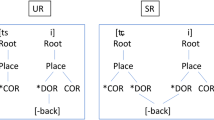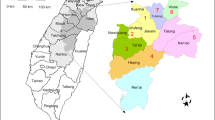Abstract
The well-known contrast in Russian between palatalized and non-palatalized consonants originated roughly one thousand years ago. At that time consonants were allophonically palatalized before front vowels, as in danj I. When the ‘jer’ (high, lax) vowels disappeared in certain positions, the palatalization formerly triggered by the front jer remained, leading to a palatalization contrast across most consonant types, e.g., danj I ‘tribute’ vs. dan ‘given’ (< danʊ). At the same time or soon thereafter, a rule is said to have been established by which /i/ surfaced as [ɨ] after non-palatalized consonants, e.g., ot ɨmjenji ‘on behalf of’ (< otʊ jenji This paper analyzes these two sound changes within a version of Dispersion Theory (DT, Flemming 1995a) elaborated by Ní Chiosáin & Padgett (2001) and Padgett (1997, to appear). DT differs from other current models of phonology in its fundamentally systemic orientation: constraints evaluate not only isolated forms as is usual, but sets of forms in contrast. References to these systems of contrast is key to the statement of constraints governing the perceptual distinctiveness of contrasts on the one hand, and constraints directly penalizing merger (neutralization) on the other. The analysis of the Russian facts here illustrates how this theory works, and provides an explanation for the otherwise mysterious allophonic /i/→ [ɨ] rule, and for the historical emergence of this rule as a consequence of the loss of the jers.
Access this chapter
Tax calculation will be finalised at checkout
Purchases are for personal use only
Preview
Unable to display preview. Download preview PDF.
Similar content being viewed by others
Editor information
Editors and Affiliations
Rights and permissions
Copyright information
© 2003 Springer Science+Business Media Dordrecht
About this chapter
Cite this chapter
Padgett, J. (2003). The Emergence of Contrastive Palatalization in Russian. In: Holt, D.E. (eds) Optimality Theory and Language Change. Studies in Natural Language and Linguistic Theory, vol 56. Springer, Dordrecht. https://doi.org/10.1007/978-94-010-0195-3_12
Download citation
DOI: https://doi.org/10.1007/978-94-010-0195-3_12
Publisher Name: Springer, Dordrecht
Print ISBN: 978-1-4020-1470-3
Online ISBN: 978-94-010-0195-3
eBook Packages: Springer Book Archive




